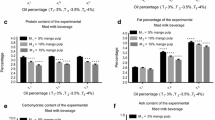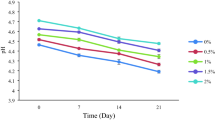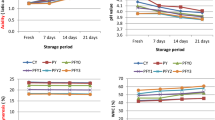Abstract
The fermented foods are same as traditional food, in appearance and consumed as normal foods but have modified by the addition of certain pro & pre-biotics or fortification with the plant extract, which have specific physiological roles beyond just satisfying nutrition requirement. Fresh leaves of Moringa oleifera were collected from the field of Institutes of Agriculture Sciences, then dried and grounded. The proximate analysis of dried moringa leaf powder and milk was performed. In four different concentrations (0.5%, 1%, 1.5% and 2%) Moringa Oleifera leaf powder, was used for the production of fortified flavoured yogurt, while mango flavor and color was added to enhance its sensory characteristics. Physicochemical analysis (pH, acidity, ash, fat, protein, fiber, synersis, total solid content and moisture content) was done to check the yogurt nutritional profile and effect of moringa dried leaf powder on it. Sensory evaluation (body texture, appearance, color, taste, aroma, flavor and overall acceptability) is also done by expert panel of food scientist (n = 20) by using hedonic scale to check the acceptability and quality of product.To check the product shelf life stability, product is stored at 5 ± 1 ºC for 15 days and observed for its physicochemical changes and sensory attributes. The sample were analyzed for their stablity as fresh and during storage interval of 10th day and 15th day. Results shows that mango flavored yogurt supplemented with 1% Moringa Oleifera leaf powder has got the highest score in majority of the sensory attributes such as body and texture, flavor, taste and overall acceptability over the storage period of 15 days at 5 ± 1 °C. All treatment showed significantly different (p ≤ 0.05) result from each other. However, higher acidity%, total solids%, protein% and synersis value were observed, than control samples on 0 days (fresh), 10 days and 15 days storage, respectively. While all treatments have less pH and moisture content than control during fresh condition and over storage time of 15 days while fat content was nearly same in all treatments and control sample.



Similar content being viewed by others
Data availability
The data generated or analysed during this study are included in this published article in supplimentory information files.
References
Abbas RK, Elsharbasy FS, Fadlelmula AA (2018) Nutritional values of Moringa oleifera, total protein. amino acid, vitamins, minerals, carbohydrates, total fat and crude fiber, under the semi-arid conditions of sudan. J Microb Biochem Technol 10:56–58
Abou El Samh MM, Sherein AA, Essam HH (2013) Properties and antioxidant activity of probiotic yoghurt flavored with black carrot, pumpkin and strawberry. Intern j Dairy Sci 8:48–57
Ahmed EL-Soda NHM, Hassan AN, Frank J (2005) Improving the textural properties of an acid-coagulated (Karish) cheese using exopolysaccharide producing cultures. LWT 38:843–847
Amal A, Eman A, Nahla SZ (2016) Fruit flavored yogurt: Chemical, functional and rheological properties. Int j Environ Agric Res 2:57–66
Anwar F, Ashraf M, Bhanger MI (2005) Interprovenance variation in the composition of Moringa oleifera oilseeds from Pakistan. J Am Oil Chem Soc 82(1):45–51
AOAC (2005) Official methods of analysis, 18th edn. Association of Officiating Analytical Chemists, Washington, DC
Asfour HAE, Anwer AM (2015) Some bacteriological and immunological studies on camel’s milk. Alex J Vet Sci 47:38–46
BakrI A, MohamedTH TAA, El-Gazzar F (2015) Characteristics of bioyoghurt fortified with fennel honey. Int J Curr Microbiol Appl Sci 4:959–970
Daba M (2016) Miracle tree: A review on multi-purposes of moringa oleifera and its implication for climate change mitigation. Journal of Earth Science & Climatic Change 7:1
Dary O, and Hurrell R (2006) Guidelines on food fortification with micronutrients. World Health Organization, Food and Agricultural Organization of the United Nations: Geneva, Switzerland, 1–376.
Dixit N K, HossainS K A, Bharti B K, Singh S S, Mishra S (2018) Development of lassi using whey and moringa powder.Int J Curr Microbiol Appl Sci 7: 602–612
El-GammalRE AEA, Darwish MS (2017) Utilization of aqueous extract of moringa oleifera for production of functional yogurt. JFDS 8:45–53
Fahey JW (2005) Moringa oleifera: a review of the medical evidence for its nutritional, therapeutic, and prophylactic properties. Part 1. TFLJ 1(5):1–15
Foidl N, MakkarH PS, Becker K (2001) The potential of Moringa oleifera for agricultural and industrial uses. The Miracle Tree: The Multiple Attributes of Moringa, 45–76
Fuglie L J (2001) The miracle tree; the multiple attributes of moringa ,Technical Centre for Agricultural and Rural Co-operation, Wageningen Países Bajos.
GaoX,Wang W,Wei S L, LiW(2009) Review of pharmacological effects of Glycyrrhiza radix and its bioactive compounds. China Journal of Chienese Materia Medica. 21 2695–2700.
Hassan FAM, Bayoumi HM, El-Gawad MA, EnabAK YYB (2016) Utilization of moringa oleifera leaves powder in production of yoghurt. Int j Dairy Sci 11:1811–9743
Hassan LK, Hagag HF, Elkalyoubi MH, El-Aziz MA, El-Sayed MM, SayedA F (2015) Physico-chemical properties of yoghurt containing cress seed mucilage or guar gum. AOAS 60:21–28
HorwtizW, Latimer GW(2006). Association of Officiating Analytical Chemists. 18 Edittion. Washinton DC.
Khalid AR, MustafaMI BMQ, Lateef M (2013) Quality assessment of milk available to the consumers in Faisalabad. Punjab University Journal of Zoology 28:7–13
Madukwe EU, Ezeugwu JO, EmeP E (2013) Nutrient composition and sensory evaluation of dry moringa oleifera aqueous extract. Int J Sci Basic Appl 13:100–102
Milner JA (2002) Functional foods and health: a US perspective. Br J Nutr 88:152–158
Razis AFA, Ibrahim MD, Kntayya SB (2014) Health benefits of Moringa oleifera. Asian Pac j Cancer Prev 15:8571–8576
Rweyemamu LM (2006) Challenges in the development of micronutrient-rich food ingredients from soya beans and Moringa oleifera leaves. Proceedings on Moringa and Other Highly Nutritious Plant Resources: Strategies, Standards and Markets for a Better Impact on Nutrition in Africa. Accra, Ghana, 37–40.
SalemA S, SalmaW M, HassaneinA M, El-GhandourH MA (2013) Enhancement of nutritional and biological values of Labneh by adding dry leaves of moringa oleifera as innovative dairy products. World Appl Sci j 22:1194–1602
Schmidt B.D. (2005), Association of Official Analytical Chemists. 18 Edition.Virginia.
Shalini S, Shivaprasad HN (2017) Moringa oleifera - Nutritional rich functional food. Int j Herb 5:83–86
ShokeryE S, El-Ziney M G,Yossef A H, Mashaly R I (2017) Effect of green tea and Moringa leave extracts fortification on the physicochemical, rheological, sensory and antioxidant properties of set-type yoghurt. ADR
Sodamode A (2013) Proximate analysis, mineral contents and functional properties of Moringa oleifera leaf concentrate. AQCJ 4(6):47–51
Soukoulis C, Lyroni E, Tzia C (2010) Sensory profiling and hedonic judgement of probiotic ice cream as a function of hydrocolloids, yogurt and milk fat content. LWT 9:1351–1358
Yaméogo CW, Bengaly MD, Aly S, Nikiema PA, Traore SA (2011) Determination of chemical composition and nutritional values of Moringa oleifera leaves. Pakistan Journal Nutr 10:264–268
Acknowledgements
We acknowlagde Dr.Amna saeed and Dr.Hafiz Roy Umair’s effort to provide help regarding proof reading and giving writting assitance for the article. The work described has not been published before (except in the form of an abstract, a published lecture or academic thesis) in any journal before and data transparency is maintained. It is not under consideration for publication elsewhere. Its submission to JFST publication has been approved by all authors.If accepted, it will not be published elsewhere in the same form, in English or in any other language, including electronically without the written consent of the copyright holder, and JFST will not be held legally responsible should there be any claims for compensation or dispute on authorship.
Funding
This study was not funded by any organization.
Author information
Authors and Affiliations
Contributions
MS concieved and carried out the experiments and wrote the MS, while SWA concieved the idea, superviosed the research and helps in editting the manuscript.SR helps in statistical analysis of the resaerch data.
Corresponding author
Ethics declarations
Conflict of interest
All the authors do not have any objection or conflict of interest towards this submission.
Additional information
Publisher's Note
Springer Nature remains neutral with regard to jurisdictional claims in published maps and institutional affiliations.
Rights and permissions
About this article
Cite this article
Saeed, M., Ali, S.W. & Ramzan, S. Physicochemical analysis of mango flavored yogurt supplemented with moringa oleifera leaf powder. J Food Sci Technol 58, 4805–4814 (2021). https://doi.org/10.1007/s13197-021-05146-w
Revised:
Accepted:
Published:
Issue Date:
DOI: https://doi.org/10.1007/s13197-021-05146-w




